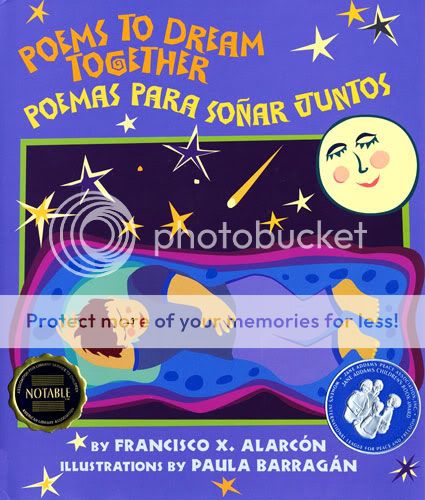I don’t like having to fess up, but I’ve never been a very big fan of poetry. I don’t want to sound ignorant. I’m a writer. I know about the power and beauty of words. I just think that it has to do with the fact that I was never really exposed to it. I want the opposite to be the case for my niños, so I’ve been searching for the kind of children’s poetry that would engage them. Now I am confident I’ve found it: “Poems to Dream Together/Poemas para Soñar Juntos” by Francisco X. Alarcón with illustrations by Paula Barragán.
“I write poetry for children because I believe poetry is a direct way to empower children, so that they can themselves not just as “readers “of poetry but as “creators” of poetry,” Alarcón, an award-winning Chicano poet, explained. “I hope my poems would inspire children and grown-ups to write their own poems.”
I can actually envision my daughter, Vanessa, one day doing this as she already comes up with short cuentos about her everyday events which she loves to share with anyone who’s willing to listen. In the meantime, Alarcón’s collection of poems has been the perfect addition to our children’s library mostly because of the subject matter: a journey into the world of dreams through the eyes of a child. Although I’m not too sure how much Vanessa understands the concept of dreaming, she has (unfortunately) experienced having nightmares. Therefore, this is a topic we’ve talked about and Alarcón’s book has been instrumental in exploring it.
“The book begins with a child still in bed daydreaming and it ends with the same child dreaming about all the members of his family joining hands forming a circle in a collective dream,” said Alarcón about his collection which includes some dreamy poems about his own childhood. “Although I have never met Paula Barragán, she totally captured the main core of my collection of poems that are based on the ancient Mesoamerican notion that can be summarized: “from the square to the circle,” that is, from the individual person to the collective sense involved in forming a circle.”
 Dreaming is so much more than just the physical act of going to sleep and traveling to a fantasy world and Alarcón, does a wondrous job of describing all the different forms it can take. His bilingual poems have to do with family, communities working together and the things we wish for our future. There’s even an ode to civil rights activist Cesar Chavez. The award-winning Chicano poet said the inspiration for this collection came from the poems schoolchildren wrote as a response to a lesson he presented regarding writing about the dreams they had about their own future, particularly the ones from the bilingual Oyster Elementary School in Washington, D.C.
Dreaming is so much more than just the physical act of going to sleep and traveling to a fantasy world and Alarcón, does a wondrous job of describing all the different forms it can take. His bilingual poems have to do with family, communities working together and the things we wish for our future. There’s even an ode to civil rights activist Cesar Chavez. The award-winning Chicano poet said the inspiration for this collection came from the poems schoolchildren wrote as a response to a lesson he presented regarding writing about the dreams they had about their own future, particularly the ones from the bilingual Oyster Elementary School in Washington, D.C.
One of the poems in particular has grabbed my daughter’s attention to the point that we’re planning her first camping trip for as soon as the weather permits. It’s the one titled “For Better Dreams/Para Soñar Mejor” and it has to do with letting your imagination run wild while spending time in nature. The vibrant images show a group of kids laying down at a campsite checking out the starry night.
One of the stanzas of the poem says:
“acuéstate afuera
y deja que tus ojos
se pongan a explorar“
To which Vanessa has responded by saying: “Yo quiero ir a (a)campar y dormi(r) afuera con las estrellas.” (I want to go camping and sleep outside with the stars.) It seems as if this is exactly one of the things Alarcón was trying to accomplish…
“I believe my book can bring families, both parents and their children, and educators and students, to read together the poems and then to initiate a discussion about them and how the poems relate to their own family experiences,” said Alarcón. “I believe reading aloud books in Spanish and English to bilingual children is crucial in developing their cognitive and literacy skills. My book is rather easy to read in both English and Spanish. The poetic, lines are short, the stanzas are symmetrical and compact.”
The bilingual book, published by Lee & Low—another remarkable independent children’s book publisher which caters to children of color and focuses on diversity—was not originally written all in English and translated to Spanish, like the work of other author’s we’ve featured in ReadMe in the past. In fact, Alarcón wrote some of the poems in this collection in Spanish and translated them to English and some other in English and translated them to Spanish, which, I can only imagine, was an awesome feat. Without a doubt, this is the reason why the poems have such an authentic rhythm.
“I believe my bilingual poetry is a reflection of the linguistic reality form by 45 million Latinos currently living in the United States, the majority of them have a direct connection with the Spanish language or are English/Spanish bilinguals to a certain degree,” he explained. “I was born in Los Angeles but I was also raised in Guadalajara. So, I was raised in both the U.S. and Mexico. I came back to California where I have lived ever since I was 17 years old. So, I am bilingual and consider myself to be bi-national and bicultural as well.”
Here’s the rest of the interview with Francisco X. Alarcón:
As a writer, can you talk about the importance of literacy among the Latino community?
“Developing literacy skills in the Latino community is probably one the most important steps in achieving a better life in this country. Literacy is a key element for obtaining a better education that leads to social mobility. My own family is an example of this process of achieving the American Dream through education. I come from a working-class immigrant family from Mexico with seven siblings: Tony, the eldest brother is now a doctor in Los Angeles, an urologist who has his own clinic; Arturo is an architect and artist; I am the third son in the family, the poet and educator; Carlos is a Catholic priest, now director of vocations for a Catholic priest order; Betty is a dentist with her own practice and now also a professor in a dental university in Orange County: Sammy is an electrical engineer; and Esthela is a successful freelance publicity in Spanish specialist. They all live and work in Southern California. Education was the main door that allows us to achieve our professional goals. On the other hand, the school dropout rate among Latino youth is alarming and totally unacceptable. Current statistics are a call to effective action: 55% of Latinos don’t graduate from high school, only 20% of Latino high school graduates are prepared to attend college, and only 2% graduate from college. Promoting literacy skills among Latino children is a crucial part of the answer to this troubling social problem.”
What do you think about the concept of raising kids bilingual and bicultural?
“I really believe that being bilingual and bicultural is a tremendous asset and not a “problem” in today’s world. I am able to travel, teach, do poetry presentation, and publish with no language problem at all in Mexico, Argentina, Chile, Spain, and all over the Spanish-speaking world and do the same in the United States. I feel at home where I now live in Davis, California, and feel the same way when I stay for three months in Mendoza, Argentina. I have three nieces who are being raised to be true English/Spanish bilinguals and attend a Spanish immersion elementary
school in Long Beach, California, and their nanny is from Brazil, so they speak Portuguese as well. The ideal goal for an educated person should be as multilingual and multicultural as possible.”
How and why did you become a writer?
“I have been writing poetry since I was 13 years old. My initial inspiration was my paternal grandmother in Mexico. I started to write poems by writing down her songs because I had to make up for some missing verses in the traditional ballads she had composed orally. I published my first book of bilingual poems for grown-ups in 1985. Later I became aware that there were almost no books of bilingual poems children written by any Latino poet in the United States, and so I wrote and published my first book of bilingual poems for children in 1997, “Laughing Tomatoes and Other Spring Poems” (Children’s Book Press). I published three additional books to complete the “Magical Cycle of the Four Seasons” of the year. My latest book, “Animal Poems of the Iguazú / Animalario del Iguazú” (Children’s Book Press 2008) is a celebration of a natural wonder of the world.”

Francisco X. Alarcón
Francisco X. Alarcón is a renowned poet and educator and a three-time winner of the Pura Belpré Author Award Honor for his bilingual Magical Cycle of the Seasons series of poetry for children. His many other honors include the American Book Award, the PEN Oakland Josephine Miles Award, the Chicano Literary Prize, and finalist for state poet laureate of California. Alarcón is also the author of several poetry collections for adults and textbooks for teaching Spanish. He lives in Davis, California, where he teaches and directs the Spanish for Native Speakers Program at the University of California.
The Giveaway
This giveaway is now closed. Congratulations to our winner #7 Melanie (Modern Mami)!! Thanks all for entering!
For your chance to win a copy of “Poems to Dream Together” and see for yourself why we chose to feature this book in this month’s ReadMe, please share with us what dreams YOU have for your bilingual/bicultural children!
This giveaway ends at midnight EST on Friday, April 2, 2010. Entries/Comments that do not follow the submission guidelines will be invalid and automatically deleted. Sorry, just need to keep it fair. Good luck to all!





Dear Roxana, Thank you very much for your nice and insightful article. It is encouraging to learn that poetry does have an impact on children and their families. Best wishes, Francisco Alarcon
Francisco,
Thank you for your inspiring answers and for your enchanting work. I can’t wait to explore the rest of your books which I’ll be sure to share with our readers!
The stories of your and your siblings’ success is refreshing and encouraging and we need more like them. Just this week, I wrote a story for the local paper about an amazing young immigrant who came to this country at the age of 11 and didn’t speak a word of English. Today, he is a fully bilingual junior in his high school’s International Baccalaureate program. Sí se puede!!
The author story is very inspiring and I hope that my two sons will be equally fluent and comfortable in any English or Spanish speaking situation.
.-= Adriana´s last blog ..Spring is FINALLY here! =-.
I hope they will learn to speak Spanish and love the Latin American culture. I hope they can live in Latin America someday
.-= Tati´s last blog ..Spanish Immersion Kindergarten Activities =-.
I hope that my girls will be better citizens of the world by seeing from an early age how alike we all are. I am going to have to check out my favorite kids’ book store for this one!
I hope my children are proud human beings. Proud of where they come from, and proud to teach their children about their culture.
.-= Marcela´s last blog ..in Kansas City… =-.
I hope my sons grow up to be humble and open-minded human beings with a love of learning.
I hope my children will be proud of who they are. I hope they are happy about the background they come from and optimistic for the futures of their own children someday.
My dreams for my baby girl are that she can grow up loving her 3 cultures and hopefully be fluent in Spanish – enough to carry a conversation. But, mostly, I just want her to embrace the beauty of having a multicultural life/family.
.-= Melanie (ModernMami)´s last blog ..Win a Wii and Wii Fit Plus Bundle! =-.
I am bilingual and very much want my two grand daughters to be as well. I think learning a second (third, forth!) language opens up the world and new opportunities.
I hope my granddaughters will speak Spanish and love the culture and people as I do. It has enriched my life.
.-= Gingerannbeck´s last blog ..Peep and the Big Wide World Giveaway =-.
Thank you for the detailed information. I have a poetry book from my childhood whose lines still repeat in my head. Maybe this book will become my son’s favorite someday. My dream is for him to live up to all his potential for loving other people and being a positive for other people, and to be very happy being in his own skin.
Happiness and success are what are wished.
i speak four languages and my son is learning 2, croatian and spanish, so i want him to know at least 3 different languages.
My dream is for success and happiness.